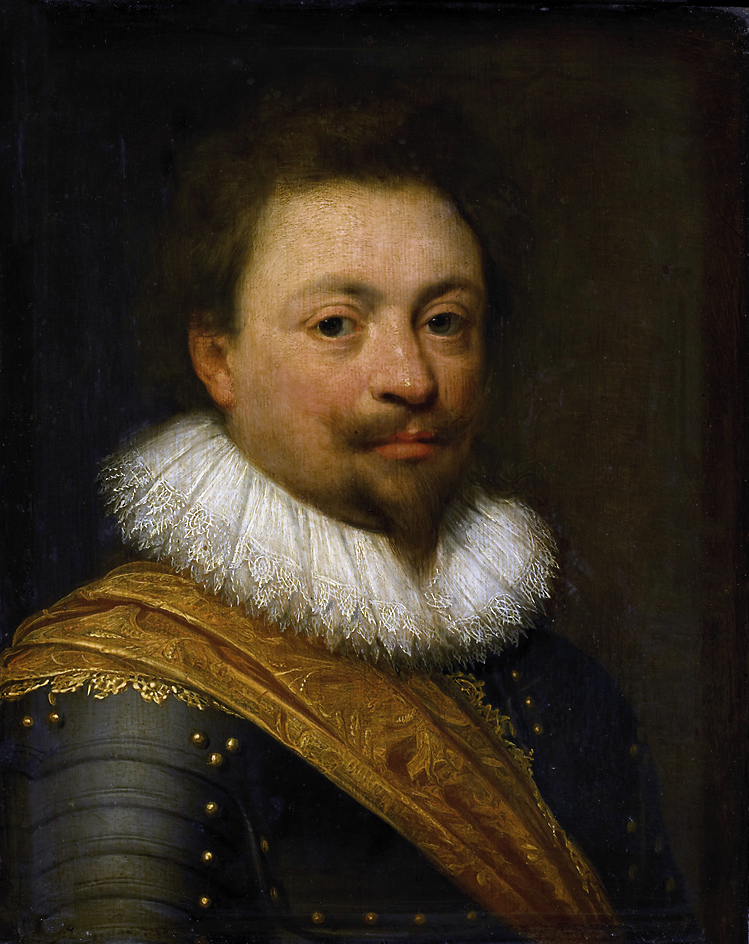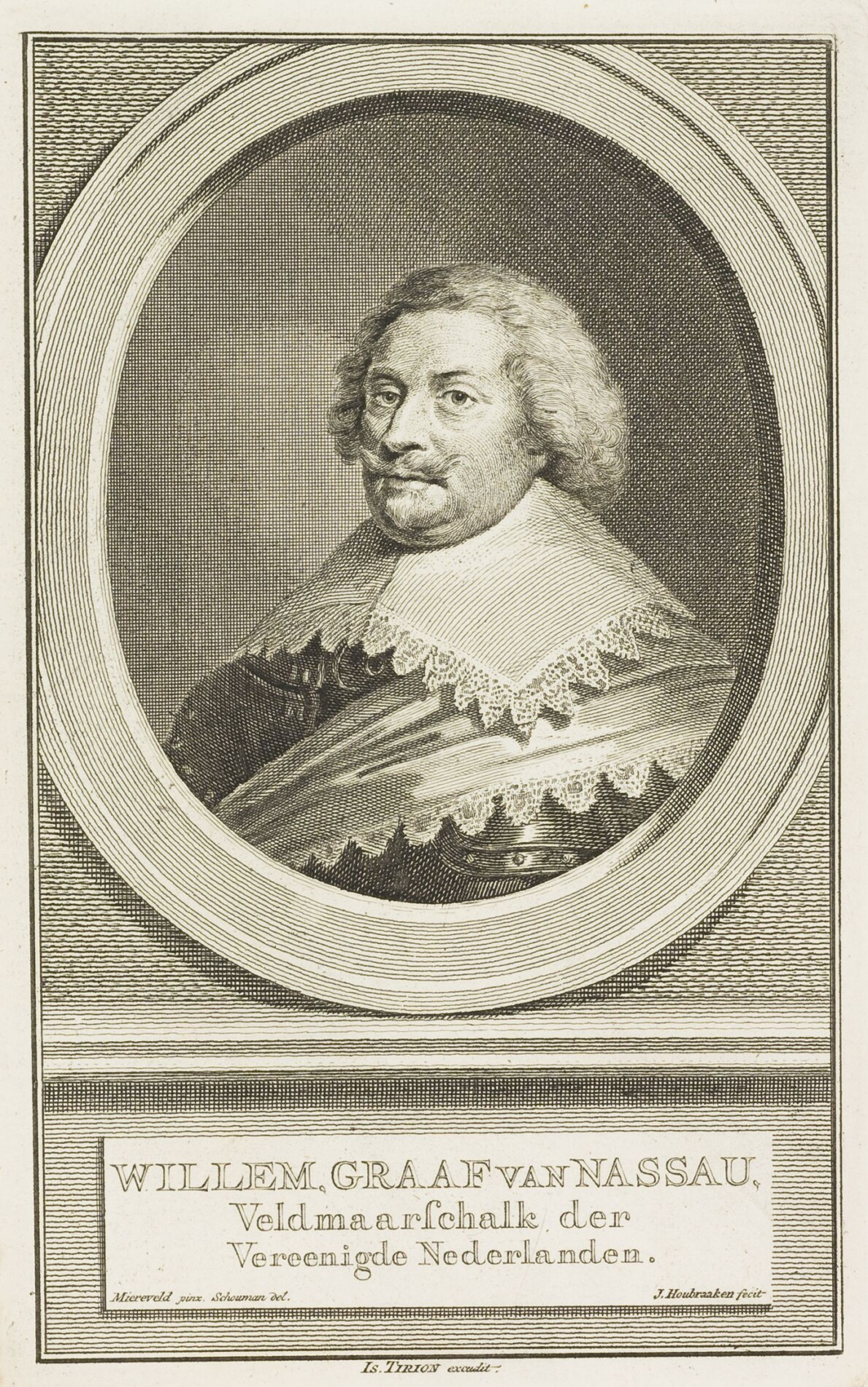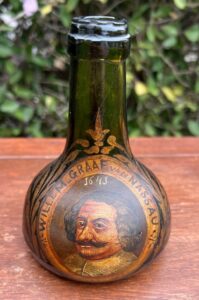
18th Century Dutch Painted Horse Hoof Bottle Depicting William Count of Nassau-Siegen
18th Century Dutch Painted Horse Hoof Bottle Depicting William Count of Nassau-Siegen
Item #CC-0820 | 18th Century Dutch Painted Horse Hoof Bottle Depicting William Count of Nassau-Siegen
Origin: Holland or Belgium
Date of Manufacture: Circa 1700-1750
Type: Short neck horse hoof
Dimensions: 5″ tall x 3.5″ wide base
Condition: Excellent with a few minor paint chips
Description: This is a very rare Dutch hand blown bottle known as a short neck horse hoof. Bottles like this held a variety of contents including, liqueurs, oils, vinegar, and a wide range of pharmaceuticals. The fact that this bottle has survived for over 350 years and traveled from Europe unbroken or cracked is nothing short of a miracle. Bottles like this were often decorated by Dutch painters with floral motifs, landscapes, to commemorate naval or military victories, honor dignitaries and heroes, and a wide variety of other artwork.
 On the front side of this bottle is displayed a portrait of William Graaf van Nassau-Siegen (13 August 1592 – 17 July 1642) with the date “1641” painted above his portrait. The word “Graaf” is the Dutch word for a Count, which is a a high-ranking nobleman with jurisdiction over a county or province. This title would be similar to and English Earl.
On the front side of this bottle is displayed a portrait of William Graaf van Nassau-Siegen (13 August 1592 – 17 July 1642) with the date “1641” painted above his portrait. The word “Graaf” is the Dutch word for a Count, which is a a high-ranking nobleman with jurisdiction over a county or province. This title would be similar to and English Earl.
William was a professional soldier who served in the armies of the Hanseatic League and the Republic of Venice, then with the Dutch States Army during the Eighty Years War. On the back side of the bottle is a golden lion rampart on a blue shield, which represents the arms of the Dutch republic and specifically the province of Nassau. A golden lion rampant is a significant symbol in 17th century Dutch heraldry. It describes a lion standing upright on one or both hind legs. Its forelegs are raised, claws unsheathed, as if ready to strike. The lion is typically shown in profile, facing left (dexter), with a fierce expression. This posture conveys:
1) Courage and readiness for battle.
2) Royal authority and sovereignty.
3) Defiance and strength, especially in the context of resistance or independence.
William’s military career was marked by steady advancement and a number of strategic appointments. He played a significant role in the final phase of the Eighty Years War that ultimately led to the Dutch gaining their independence from Spain.
In 1633, William was promoted to the rank of Field Marshal, succeeding his uncle, Count Ernest Casimir of Nassau-Diez. He also held gubernatorial posts in the fortified towns of Emmerich, Heusden, and Sluis, underscoring his importance in regional defense and administration.
Campaigns and Engagements
William participated in a number of battles and military actions including:
- The siege of ‘s-Hertogenbosch (1629): William established his headquarters in Orthen, initiating the bombardment of the city on 15 May. ‘s-Hertogenbosch had remained loyal to the Spanish crown since 1579 and was a key stronghold in the Spanish Netherlands.
- The defense of Bommelerwaard: Tasked by Frederick Henry Prince of Orange, William led 24 infantry companies and cavalry units to prevent an incursion by Hendrik van den Bergh, commander of the Spanish Army of Flanders.
- The siege of Maastricht (1632): William participated in the campaign led by Frederick Henry Prince of Orange, contributing to the capture of strategic fortifications near Antwerp and throughout Flanders. Later in 1632, William was appointed ritmeester (cavalry master) of the cuirassiers—a heavy cavalry unit equipped with armor, swords, and pistols.
- The capture of Schenkenschanz (1636): Alongside his brother, John Maurice of Nassau, William successfully seized the heavily fortified Schenkenschanz from Spanish control.
In 1638, Frederick Henry Prince of Orange entrusted William with the occupation of the levee at Calloo. After capturing the fortifications at Stabroek and Calloo and dispersing Spanish forces, William halted his advance to await reinforcements. Misled by erroneous intelligence suggesting a superior Spanish force was approaching, he ordered a retreat. This decision led to a devastating defeat at the Battle of Kallo on 17 June, where over 2,000 Dutch troops were lost, including William’s 17-year-old son, Maurice Frederick.
Final Campaign and Death
 During the Siege of Gennep in 1641, William sustained a musket wound to the abdomen. Despite medical efforts, he succumbed to his injuries the following year, marking the end of a remarkable career and service to the Dutch Republic.
During the Siege of Gennep in 1641, William sustained a musket wound to the abdomen. Despite medical efforts, he succumbed to his injuries the following year, marking the end of a remarkable career and service to the Dutch Republic.
For more detailed information on the life and history of William Count of Nassau-Siegen, visit: William, Count of Nassau-Siegen – Wikipedia
For more detailed information on the Eighty Years War and William’s involvement, visit: The Eighty Years War – Wikipedia

